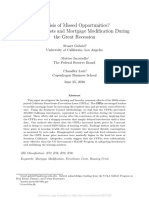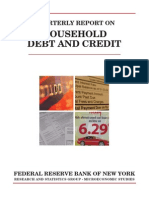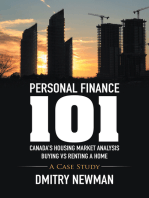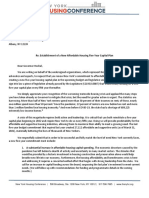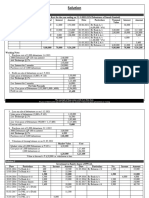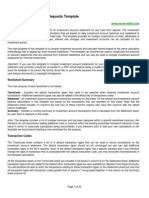Foreclosure0815 PDF
Foreclosure0815 PDF
Uploaded by
Nick ReismanCopyright:
Available Formats
Foreclosure0815 PDF
Foreclosure0815 PDF
Uploaded by
Nick ReismanOriginal Title
Copyright
Available Formats
Share this document
Did you find this document useful?
Is this content inappropriate?
Copyright:
Available Formats
Foreclosure0815 PDF
Foreclosure0815 PDF
Uploaded by
Nick ReismanCopyright:
Available Formats
Local Government Snapshot
N E W YO R K S TAT E O F F I C E O F T H E S TAT E CO M P T R O L L E R
Thomas P. DiNapoli State Comptroller
2013
46,696
39,521
2014
43,868
39,057
August 2015
The Foreclosure Predicament Persists
New York State continues to experience
Figure 1.
high levels of foreclosure activity. The Office
Foreclosure Cases Filed in New York State
of the State Comptroller (OSC) reported on
the foreclosure problem in 2012, highlighting
Filings fell after new anti-robo-signing court
rules were issued in October 2010, but then rose as
its impact on local governments in New
lenders adjusted to meet the new requirements.
York State.1 Since then, trends in both new
foreclosure filings and the total number of
47,664
46,696
46,572
pending foreclosure cases indicate that
43,868
41,201
the problem is far from resolved. Although
33,508
new foreclosure filings have shown signs
26,706
of leveling off since 2013, they remain
25,411
significantly higher than prerecession levels.
In addition, the States courts are
16,655
experiencing difficulties working through a
large backlog of foreclosure cases pending
2006 2007 2008 2009 2010 2011 2012 2013 2014
in the States long and complicated judicial
foreclosure process. This large pool
Source: New York State Unifiied Court System. Years are based on Court System
reporting periods. New court rules issued in 2010 required lenders to certify the
of properties in legal limbo weighs on
accuracy of the documents they present to the court.
local governments vitality in many ways,
including reducing property values, eroding
tax bases and propagating blight.
Figure 1.
In 2015, a number of major banks and
mortgage servicing companies operating
in New York State agreed to follow a set
of best practices in managing vacant
and abandoned properties with delinquent
mortgages even before the foreclosure
process begins.2 The practices include
inspecting, securing and maintaining the
properties throughout the delinquency
of the loan. This is a promising
development. Ultimately, however, all of
the stakeholdersincluding the courts,
the banks, local governments and other
groupsmust continue efforts to clear
the backlog of pending cases to stem the
spread of foreclosure-induced blight.
Trends in both new foreclosure
filings and the total number
of pending foreclosure cases
indicate that the problem is far
from resolved.
Division of Local Government and School Accountability
Local Government Snapshot
Statewide, New Foreclosure Filings Remain High, While Growth in Pending Cases
Has Tapered Off
Foreclosure filings rose rapidly after the housing
bubble burst and the recession of 2008-2009
took hold. As shown in Figure 1, between 2006
and 2009, the number of new foreclosure cases
filed jumped from 26,706 to 47,664, an increase
of 78 percent.3 In 2011 and 2012, new filings
declined as new court rules were issued requiring
lenders to affirm their claim to the property
(in response to instances of robo-signing, in
which lender representatives signed documents
without reviewing them).4 Since reaching a low
of 16,655 in 2011, filings climbed to 46,696 by
2013 before edging back to 43,868 in 2014, still
well above prerecession levels.
As shown in Figure 2, the number of pending
foreclosure cases has begun to level off after
growing by 27 percent between the beginning
of 2013 and mid-2014 (from 72,183 to over
91,600).
Figure 2.
Total Pending Foreclosures:
Jan. 2013 thorugh Feb. 2015 by Court Term
Statewide, from January 2013
through May 2014, the number
of pending foreclosure cases
100,000 grew by 27 percent.
95,000
90,000
85,000
80,000
75,000
70,000
65,000
91,620
92,070
Since May 2014, growth
has tapered off.
72,183
2013 2013 2013 2014 2014 2014
Term 1 Term 6 Term 11 Term 3 Term 8 Term 13
(Jan.) (May-Jun.) (Oct.-Nov.) (Mar.)
(Jul-Aug.) (Dec.-Jan.)
Source: New York State Unified Court System. Each year has 13 court terms with Term 1
beginning in early January.
Downstate Counties Outside of New York City Have Been Most Affected
Foreclosures are hitting some regions harder than others.
The downstate area outside of New York City
(Long Island and the Mid-Hudson region) has
the greatest number of pending foreclosures,
and has experienced relatively rapid growth
in the number of pending foreclosure cases
over the past two yearsfrom 25,097 at the
beginning of 2013 to 40,985 two years later, an
increase of 63 percent.5
Upstate, growth in pending cases was slower
over the same period, but still substantial: a 47
percent increase in pending cases.
In New York City, by contrast, the number of
pending foreclosure cases dropped nearly 10
percent between 2013 and 2015.
Figure 3.
Pending Foreclosure Cases by Region
(Snapshot at beginning of the year)
45,000
40,000
35,000
30,000
25,000
20,000
15,000
10,000
5,000
0
Downstate, Excluding
New York City
New York City
Upstate
2013
2014
2015
Source: New York State Unified Court System. Data is as of Term 1 of the annual court
calendar (corresponding roughly to the month of January). Downstate includes Long
Island and the Mid-Hudson region.
N e w Yo r k S t a t e O f f i c e o f t h e S t a t e C o m p t r o l l e r
Local Government Snapshot
Gauging the Magnitude of the Problem at the County Level
Looking only at numbers of properties in foreclosure, it is not possible to get a sense of the prevalence of
foreclosure activity in particular areas of the State. One indicator that conveys the severity of the problem is the
foreclosure rate, which represents pending foreclosure cases as a percentage of housing units. This rate is
an approximate measure, however, because the foreclosure cases include both residential and nonresidential
properties and a single foreclosed property may have multiple housing units. For example, a residential property
with four apartments counts as four housing units, even if the property has only one mortgage. Despite these
limitations, the measure offers a means of comparing the scope of the problem across regions and counties.6
Statewide, the pending caseload in 2015 represents 1.13 percent of housing units, which amounts to 1 in 88
housing units.
The foreclosure rate is up from 0.89 percent at the beginning of 2013 (or 1 in 112 housing units). As expected,
however, the situation varies widely across the State.
Figure 4 graphs the county-level data showing the percentage change in the number of pending foreclosure
cases from the beginning of 2014 to the beginning of 2015 (Term 1 of the court calendar, which corresponds
roughly to the month of January) on the horizontal axis and the foreclosure rate on the vertical axis. Where
each county falls relative to these two axes gives a sense of the relative severity of the problem in each county.
The upper right quadrant shows the counties where the foreclosure problem is most acute: those with both
increasing foreclosure caseloads and high foreclosure rates. Except for Suffolk County, all of the downstate
counties outside New York City occupy the upper right quadrant.
Also, the four counties with the highest foreclosure rates are all located downstate: Suffolk (2.82 percent,
or one in every 35 housing units), Nassau (2.47 percent, or one in every 40 housing units), Rockland (2.26
percent, or one in every 44 housing units), and Putnam (2.10 percent, or one in every 48 housing units).
Counties in Western New York and the Finger Lakes regions, in contrast, tended to have lower pending
foreclosure rates and decreasing caseloads.
These findings are in line with previous OSC research that shows that the foreclosure problem has tended to
hit hardest in areas where the housing market had boomed in the years preceding the recession.7 What is
notable, however, is the persistence of the problem. In many places, not only has the situation not improved, but
it has continued to get worse, albeit in most cases at a somewhat slower rate.
Home Equity Loans Could Pose Additional Challenges
Defaults on home equity line-of-credit loans (HELOCs) could stall improvementparticularly in regions where
home values have not yet rebounded. During the housing boom, as home values continued to rise, many
homeowners took out long-term home equity loans that offered interest-only payments in the early years of
the amortization period before resetting to higher payments that include both interest and principal payments.
Borrowers facing HELOC resets who have substantial equity in their homes will likely refinance. However,
borrowers whose homes have lost value may owe more than their homes are worth. They will likely be unable
to refinance associated loans or pay them off by selling their homes. These borrowers could face foreclosure
if they are unable to make the new higher loan payments. RealtyTrac estimates that from 2015 through 2018 in
New York State 132,492 HELOCs originating between 2005 and 2008 will reset.8
N e w Yo r k S t a t e O f f i c e o f t h e S t a t e C o m p t r o l l e r
N e w Yo r k S t a t e O f f i c e o f t h e S t a t e C o m p t r o l l e r
-40%
-35%
Low Foreclosure Rate,
Decreasing Caseload
Low Concern:
-50% -45%
Schuyler
Median
Improving:
High Foreclosure Rate,
Decreasing Caseload
-30%
Wyoming
-25%
Yates
Cattaraugus
Chautauqua
-15%
-5%
0%
Putnam
Otsego
5%
10%
15%
Saint Lawrence
20%
At Risk:
30%
35%
Essex
Greene
Low Foreclosure Rate,
Increasing Caseload
25%
Monroe,
Niagara
Oswego
Schoharie
Warren
Ulster
Orange
40%
High Foreclosure Rate,
Increasing Caseload
Greatest Concern:
Madison
Onondaga
Columbia
Westchester
Albany
Bronx
Sullivan
Fulton
Rockland
Nassau
Montgomery
Cortland
Lewis
Saratoga
Kings
Upstate
Counties
Upstate
Counties
New
York
CityCity
Boroughs
New
York
Boroughs
Other
Downstate
Counties
Other
Downstate
Counties
-10%
New York
Allegany
Rensselaer
Dutchess
Schenectady
Change in Pending Foreclosure Cases, 2014 to 2015
-20%
Tompkins
Richmond
Orleans
Queens
Washington
Clinton
Suffolk
Source: New York State Unified Court System and U.S. Census Bureau with OSC calculations. The foreclosure rate represents pending foreclosures as a percentage of housing units.
Housing unit data is from the American Community Survey (five-year, 2013). See the appendix for the data used for this chart. Foreclosure data is based on snapshots from
Term 1 of the court calendar. Data is not available for Hamilton County.
Source: New York State Unified Court System and U.S. Census Bureau with OSC calculations. The foreclosure rate represents pending foreclosures as a percentage of housing units. Housing
unit data is from the American Community Survey (five-year, 2013). See the appendix for the data used for this chart. Foreclosure data is based on snapshots from Term 1 of the court calendar.
Data is not available for Hamilton County.
0.0%
0.5%
1.0%
1.5%
2.0%
2.5%
3.0%
2015 County Foreclosure Rate and Growth in Pending Foreclosure Cases
Foreclosure Rate, 2015
Figure 4.
Local Government Snapshot
Local Government Snapshot
Small Signs of Improvement
One sign that we could begin to see a
noticeable reduction in the statewide
pending caseload is that foreclosure
activity at the beginning of the process (lis
pendens filings, a pre-foreclosure action in
which lenders file notification of a pending
lawsuit) is slowing, while activity at the end
of the process (notices of sale, notification
that the property has been scheduled for
public auction) is accelerating. Indeed, in
New York City, the foreclosure crisis appears
to have already turned the corner, with 2014
results showing year-over-year decreases in
both lis pendens filings and notices of sale
compared to 2013. In the rest of the State,
lis pendens filings grew by only 1.3 percent
from 2013 to 2014, while notices of sale grew
by 78 percent.9
Another encouraging sign is that a number
of State governmental entitiesincluding
the Unified Court System, the Department
of Financial Services and the Attorney
Generalare making efforts to resolve
cases that have become stalled, to monitor
properties with delinquent mortgages and
to return vacant abandoned properties to
productive use. The courts are modifying their
processes to reduce the number of settlement
conference appearances per foreclosure
case and speed up the foreclosure process.10
The Department of Financial Services (DFS)
has studied the foreclosure process and
made recommendations for legislative and
administrative reforms to streamline the
process.11 DFS is also developing a registry
of vacant and abandoned properties and will
share the information with local officials.12
The New York State Attorney General has
awarded nearly $33 million to land banks
across the State. The land banks will use
the funds to combat blight by a variety
of means, including demolishing vacant
and abandoned homes, renovating and
reselling properties, and supporting other
development activities.13
Figure 5.
Activity at the Beginning of the Foreclosure Process Is
Starting to Slow...
Lis Pendens Filings, 2011 to 2014
45,000
40,000
35,000
30,000
25,000
20,000
15,000
10,000
5,000
0
25,593
11,489
25,937
17,331
9,080
10,456
2011
2012
Rest of
State
New York
City
13,928
13,120
2013
2014
While Activity at the End of the Foreclosure Process Is
Starting to Speed Up
Notices of Sale, 2011 to 2014
7,000
6,000
5,000
4,000
3,000
2,000
1,000
0
4,679
2,629
Rest of
State
New York
City
2,117
2,336
1,363
1,161
1,383
1,202
2011
2012
2013
2014
Source: Renwood RealtyTrac.
A lis pendens filing is a pre-foreclosure action in which the lender files notification of a pending
lawsuit. A notice of sale is notification that the property has been scheduled for public auction.
N e w Yo r k S t a t e O f f i c e o f t h e S t a t e C o m p t r o l l e r
Local Government Snapshot
Appendix.
County-Level Foreclosure Data
Pending Foreclosure Cases
at Beginning of Year
(Court Term 1)
County
2013
2014
2015
Pending
Foreclosure
Percentage Case Trend,
Change
2013 to 2015,
2014 to
High and Low
2015
Marked
Foreclosure Rate:
Pending
Foreclosures
as Percentage
of Housing Units
Total
Housing
Units for
Every One
Foreclosure
Case
Capital District
Albany
Columbia
Greene
Rensselaer
Saratoga
Schenectady
Warren
Washington
Capital District Total
757
229
159
571
769
937
286
277
3,985
1,062
296
247
872
923
1,207
318
403
5,328
1,241
313
326
867
948
1,239
389
393
5,716
16.9%
5.7%
32.0%
-0.6%
2.7%
2.7%
22.3%
-2.5%
7.3%
0.90%
0.96%
1.12%
1.21%
0.95%
1.82%
1.00%
1.36%
1.13%
111
104
89
82
105
55
100
73
89
Central New York
Cayuga
Cortland
Madison
Onondaga
Oswego
Central New York Total
101
124
231
842
183
1,481
209
153
233
1,398
277
2,270
197
166
277
1,629
359
2,628
-5.7%
8.5%
18.9%
16.5%
29.6%
15.8%
0.54%
0.81%
0.87%
0.80%
0.67%
0.76%
185
123
114
125
149
131
Finger Lakes
Genesee
Livingston
Monroe
Ontario
Orleans
Seneca
Wayne
Wyoming
Yates
Finger Lakes Total
152
133
1,379
138
149
50
206
78
37
2,322
181
199
2,370
259
190
72
317
93
59
3,740
173
191
2,622
254
162
79
307
66
44
3,898
-4.4%
-4.0%
10.6%
-1.9%
-14.7%
9.7%
-3.2%
-29.0%
-25.4%
4.2%
0.68%
0.70%
0.82%
0.53%
0.88%
0.49%
0.75%
0.37%
0.33%
0.74%
147
142
122
190
113
203
133
271
306
135
Long Island
Nassau
Suffolk
Long Island Total
6,374
9,729 11,554
12,313 16,227 16,046
18,687 25,956 27,600
18.8%
-1.1%
6.3%
2.47%
2.82%
2.66%
40
35
38
Mid-Hudson
Dutchess
Orange
Putnam
Rockland
Sullivan
Ulster
Westchester
Mid-Hudson Total
922
1,624
1,705
881
1,792
2,302
297
697
800
1,093
1,924
2,356
507
718
800
680
1,013
1,285
2,030
3,574
4,137
6,410 11,342 13,385
5.0%
28.5%
14.8%
22.5%
11.4%
26.9%
15.8%
18.0%
1.44%
1.67%
2.10%
2.26%
1.62%
1.54%
1.12%
1.49%
70
60
48
44
62
65
89
67
N e w Yo r k S t a t e O f f i c e o f t h e S t a t e C o m p t r o l l e r
Local Government Snapshot
Appendix.
County-Level Foreclosure Data
Pending Foreclosure Cases
at Beginning of Year
(Court Term 1)
County
2013
2014
2015
Pending
Foreclosure
Percentage Case Trend,
Change
2013 to 2015,
2014 to
High and Low
2015
Marked
Foreclosure Rate:
Pending
Foreclosures
as Percentage
of Housing Units
Total
Housing
Units for
Every One
Foreclosure
Case
Mohawk Valley
Fulton
Hamilton
Herkimer
Montgomery
Oneida
Schoharie
Mohawk Valley Total
288
NA
136
280
441
89
1,234
389
NA
187
390
657
137
1,760
445
NA
216
435
649
177
1,922
14.4%
NA
15.5%
11.5%
-1.2%
29.2%
9.2%
1.56%
NA
0.65%
1.88%
0.62%
1.03%
0.89%
64
NA
154
53
160
97
112
North Country
Clinton
Essex
Franklin
Jefferson
Lewis
Saint Lawrence
North Country Total
552
167
68
154
26
100
1,067
644
183
123
206
48
154
1,358
624
244
120
243
51
174
1,456
-3.1%
33.3%
-2.4%
18.0%
6.3%
13.0%
7.2%
1.74%
0.96%
0.48%
0.42%
0.34%
0.33%
0.69%
57
105
210
239
297
299
145
3,903
4,563
4,924
13,853 11,240 11,402
881
898
814
12,497 12,421 10,667
1,100
1,619
1,360
32,234 30,741 29,167
7.9%
1.4%
-9.4%
-14.1%
-16.0%
-5.1%
0.96%
1.14%
0.10%
1.27%
0.77%
0.86%
104
88
1043
79
130
116
694
207
194
232
377
15
232
134
81
2,166
2.8%
19.7%
-1.0%
10.5%
14.2%
-48.3%
-1.3%
8.1%
-13.8%
4.8%
0.77%
0.54%
0.79%
0.75%
1.23%
0.16%
0.48%
0.61%
0.19%
0.64%
130
185
127
134
81
630
210
165
515
156
81
109
100
233
299
225
475
535
380
1,597
2,362
2,493
536
714
792
2,922
4,019
3,990
72,183 88,580 91,928
-8.3%
-24.7%
-29.0%
5.5%
10.9%
-0.7%
3.8%
0.38%
0.55%
0.57%
0.59%
0.80%
0.61%
1.13%
260
182
176
168
125
164
88
New York City
Bronx
Kings
New York
Queens
Richmond
New York City Total
Southern Tier
Broome
Chemung
Chenango
Delaware
Otsego
Schuyler
Steuben
Tioga
Tompkins
Southern Tier Total
Western New York
Allegany
Cattaraugus
Chautauqua
Erie
Niagara
Western New York Total
Grand Total
590
212
165
171
326
21
162
113
81
1,841
675
173
196
210
330
29
235
124
94
2,066
Source: New York State Unified Court System and U.S. Census Bureau with OSC calculations. Foreclosure data is not available for Hamilton
County. Pending foreclosure counts are based on snapshot data from Term 1 of the court calendar (which covers most of the month of January).
Census data on the number of housing units is from the American Community Survey (five-year estimates with the most recent data from 2013).
Foreclosure cases include both residential and nonresidential properties, and so the foreclosure rate and total housing units for every one
foreclosure case metrics are intended to convey an approximate sense of the relative prevalence of properties in foreclosure.
N e w Yo r k S t a t e O f f i c e o f t h e S t a t e C o m p t r o l l e r
Local Government Snapshot
1
Office of the State Comptroller (OSC), Cleaning it up: The Foreclosure Problem and the Response of Local Governments (March 2012).
Available at: www.osc.state.ny.us/localgov/pubs/research/foreclosure.pdf.
Governor Cuomo Announces Major Mortgage Companies Agree to Measures to Combat Vacant Abandoned Zombie Properties, Governor
Andrew Cuomo press release, May 18, 2015,
www.governor.ny.gov/news/governor-cuomo-announces-major-mortgage-companies-agree-measures-combat-vacant-abandoned-zombie,
accessed June 3, 2015.
New York State Unified Court System, 2014 Report of the Chief Administrator of the Courts, p. 3.
New York State Unified Court System, 2012 Report of the Chief Administrator of the Courts, pp. 1-2.
Data from the New York State Unified Court System. Data is as of Term 1 of the annual court calendar (corresponding roughly to the month of
January). See the appendix for county-level data on pending foreclosures organized by region. County-level data on pending foreclosures prior to
2013 is not available.
Foreclosure figures include both residential and nonresidential properties. A property may have more than one than foreclosure case against it (if it has
more than one delinquent loan). Also, a single foreclosure case may involve properties with multiple housing units. Housing unit data is from the Bureau
of the Census (American Community Survey, five-year estimates, with most recent data from 2013). Consequently, the foreclosure rate is not an exact
figure, but rather provides an estimate of the relative scale of the foreclosure problem in different areas of the State. New York City is atypical because it
has a much greater proportion of multi-family residential properties than other regions of the State.
OSC, Upstate/Downstate: New Yorks Diverging Housing Market (June 2010).
Available at: www.osc.state.ny.us/localgov/pubs/research/snapshot/0610snapshot.pdf.
RealtyTrac, 56 Percent of 3.3 Million HELOCs Scheduled to Reset with Higher Rates in Next Four Years are on Underwater Homes (March 2015),
available at: www.realtytrac.com/news/mortgage-and-finance/heloc-resets-report/.
Data from Renwood RealtyTrac. These data do not include all foreclosure resolutions, notably settlements (where a foreclosure is avoided by
settlement between the lender and borrower) and dismissals. If a property fails to sell at auction, the title is typically transferred to the lender.
10
The efforts of the courts are discussed in the annual Report of the Chief Administrator of the Courts: Pursuant to Chapter 507 of the Laws of 2009,
available at: www.nycourts.gov/publications/index.shtml#Foreclosure.
11
New York State Department of Financial Services, Report on New Yorks Foreclosure Process (May 2015), available at:
www.dfs.ny.gov/reportpub/fore_proc_report_052015.pdf.
12
Governor Cuomo Announces Major Mortgage Companies Agree to Measures, op. cit.
13
A.G. Schneiderman Awards $20 Million to Land Banks Across New York State, New York State Attorney Generals Office, Press Release,
October 15, 2014.
New York State Office of the State Comptroller
Division of Local Government and School Accountability
110 State Street, 12th Floor Albany, New York 12236
Like us on Facebook at facebook.com/nyscomptroller
Follow us on Twitter @nyscomptroller
w w w. o s c . s t a t e . n y. u s
August 2015
You might also like
- OCM LawsuitDocument29 pagesOCM LawsuitNick Reisman100% (1)
- Matter of Demetriou V New York State Department of Health 2022-00532Document2 pagesMatter of Demetriou V New York State Department of Health 2022-00532Nick ReismanNo ratings yet
- Lic Housing FinanceDocument10 pagesLic Housing FinanceNeha GoyalNo ratings yet
- Foreclosure 11211Document8 pagesForeclosure 11211Nick ReismanNo ratings yet
- 4.29.14 CED Report PDFDocument17 pages4.29.14 CED Report PDFRecordTrac - City of OaklandNo ratings yet
- Foreclosure Funding Report Final - 0Document7 pagesForeclosure Funding Report Final - 0Celeste KatzNo ratings yet
- 2015 - 2ndQ Foreclosure ReportDocument17 pages2015 - 2ndQ Foreclosure ReportRyan McMakenNo ratings yet
- Mortgage Foreclosures in New York Testimony Before The New York State AssemblyDocument9 pagesMortgage Foreclosures in New York Testimony Before The New York State AssemblyCaesar NguyenNo ratings yet
- CED Report 1.28.14 PDFDocument16 pagesCED Report 1.28.14 PDFRecordTrac - City of OaklandNo ratings yet
- 2011 Foreclosure background paperDocument32 pages2011 Foreclosure background paperPhilip JamesNo ratings yet
- 2015 - 3rdQ Foreclosure ReportDocument17 pages2015 - 3rdQ Foreclosure ReportRyan McMakenNo ratings yet
- 7.23.13 CED Report PDFDocument12 pages7.23.13 CED Report PDFRecordTrac - City of OaklandNo ratings yet
- Foreclosures, House Prices, and The Real EconomyDocument50 pagesForeclosures, House Prices, and The Real EconomyVenkataratna PrasadNo ratings yet
- Serious Delinquency RatesDocument4 pagesSerious Delinquency RatesEditor, Hartford CourantNo ratings yet
- Crisis of MissedDocument49 pagesCrisis of MissedForeclosure FraudNo ratings yet
- Americas Rental HousingDocument36 pagesAmericas Rental HousingMariaNugrahiniNo ratings yet
- Household Debt and Credit: Quarterly Report OnDocument31 pagesHousehold Debt and Credit: Quarterly Report OnZerohedgeNo ratings yet
- Gould Ellen Et Al - What's Really Happening To The REO StockDocument37 pagesGould Ellen Et Al - What's Really Happening To The REO Stockannawitkowski88No ratings yet
- GAO ReportDocument102 pagesGAO ReportForeclosure FraudNo ratings yet
- Household Debt and Credit: Quarterly Report OnDocument31 pagesHousehold Debt and Credit: Quarterly Report OnDavid4564654No ratings yet
- Market SnapshotDocument1 pageMarket Snapshotjoy_bowlesNo ratings yet
- Income Shock MortageDocument28 pagesIncome Shock MortageBella Apriza PurwitaNo ratings yet
- Fed Reserve NY: Household Debt and Credit 4 Q 2013 Feb 2014Document31 pagesFed Reserve NY: Household Debt and Credit 4 Q 2013 Feb 2014Patricia DillonNo ratings yet
- Economic Focus 7-18-11Document1 pageEconomic Focus 7-18-11Jessica Kister-LombardoNo ratings yet
- How New York LivesDocument28 pagesHow New York Lives2joncampbellNo ratings yet
- Recent Research by Amir SufiDocument59 pagesRecent Research by Amir SufiRichardJeterNo ratings yet
- Nomura Special HousingDocument7 pagesNomura Special Housingjanos_torok_4No ratings yet
- Fall 2011 Newsletter - Jane JensenDocument4 pagesFall 2011 Newsletter - Jane JensenJane JensenNo ratings yet
- Negative Equity EstimatesDocument13 pagesNegative Equity EstimatesMartin AndelmanNo ratings yet
- Household Debt and Credit: Quarterly Report OnDocument33 pagesHousehold Debt and Credit: Quarterly Report OnTBP_Think_TankNo ratings yet
- Statement of Mark M. Fleming, PH.D., Chief Economist Corelogic, Inc. - 2010 HearingDocument26 pagesStatement of Mark M. Fleming, PH.D., Chief Economist Corelogic, Inc. - 2010 HearingEsquireNo ratings yet
- Finance and Economics Discussion Series Divisions of Research & Statistics and Monetary Affairs Federal Reserve Board, Washington, D.CDocument63 pagesFinance and Economics Discussion Series Divisions of Research & Statistics and Monetary Affairs Federal Reserve Board, Washington, D.CcaitlynharveyNo ratings yet
- Anti Blight Ordinances and Local Housing MarketsDocument37 pagesAnti Blight Ordinances and Local Housing MarketsForeclosure FraudNo ratings yet
- Us Economy CrisisDocument30 pagesUs Economy CrisisAnjali BalanNo ratings yet
- Executive Summary: Signs of Recovery in The For-Sale MarketDocument6 pagesExecutive Summary: Signs of Recovery in The For-Sale MarketBruce BartlettNo ratings yet
- 2-9-2012 Eric Schneiderman On The Foreclosure Settlement - TAKING CARE OF NEW YORKERSDocument4 pages2-9-2012 Eric Schneiderman On The Foreclosure Settlement - TAKING CARE OF NEW YORKERS83jjmackNo ratings yet
- DepressionDocument8 pagesDepressionForeclosure FraudNo ratings yet
- Monthly Foreclosure Report - March2015Document10 pagesMonthly Foreclosure Report - March2015Ryan McMakenNo ratings yet
- 2002 Three County Subprime Foreclosure ReportDocument13 pages2002 Three County Subprime Foreclosure Reportapi-254695690No ratings yet
- Negative Equity and ForclosureDocument36 pagesNegative Equity and ForclosureВафля СольNo ratings yet
- Federal Bureau of Investigation (FBI) 2009 Mortgage Fraud ReportDocument37 pagesFederal Bureau of Investigation (FBI) 2009 Mortgage Fraud Reportwmartin46No ratings yet
- Faux TestimonyDocument11 pagesFaux TestimonyDinSFLANo ratings yet
- Affordable Housing Ny 2014Document34 pagesAffordable Housing Ny 2014jspectorNo ratings yet
- Working Paper Series: Does Greater Inequality Lead To More Household Borrowing? New Evidence From Household DataDocument63 pagesWorking Paper Series: Does Greater Inequality Lead To More Household Borrowing? New Evidence From Household DataTBP_Think_TankNo ratings yet
- NJTPC AG - Press7.25Document1 pageNJTPC AG - Press7.25greergirl2No ratings yet
- An Early Warning System For Asset Bubbles: January 2010Document3 pagesAn Early Warning System For Asset Bubbles: January 2010victorpasauNo ratings yet
- RGB 2012 TestimonyDocument9 pagesRGB 2012 TestimonytomwatersNo ratings yet
- Real Property Assessment Trends in The Washington Region, 2005-2014Document12 pagesReal Property Assessment Trends in The Washington Region, 2005-2014Fauquier NowNo ratings yet
- Favara Imbs 2015 Credit Supply and The Price of HousingDocument55 pagesFavara Imbs 2015 Credit Supply and The Price of Housingshuyingyuan1998No ratings yet
- Household Finance After A Natural Disaster The Case of Hurricane KatrinaDocument31 pagesHousehold Finance After A Natural Disaster The Case of Hurricane Katrinaসামির সিয়াম স্পন্দনNo ratings yet
- Shadow Inventory DropsDocument2 pagesShadow Inventory DropsSheryl SchullNo ratings yet
- Impacts of The Widening Divide: Los Angeles at The Forefront of The Rent Burden CrisisDocument20 pagesImpacts of The Widening Divide: Los Angeles at The Forefront of The Rent Burden CrisisSouthern California Public Radio0% (1)
- Credit Losses: Projections and Policy Options (Jan. 13, 2009)Document8 pagesCredit Losses: Projections and Policy Options (Jan. 13, 2009)CarrieonicNo ratings yet
- News ReleaseDocument2 pagesNews ReleaseTime Warner Cable NewsNo ratings yet
- Personal Finance 101 Canada’S Housing Market Analysis Buying Vs Renting a Home: A Case StudyFrom EverandPersonal Finance 101 Canada’S Housing Market Analysis Buying Vs Renting a Home: A Case StudyNo ratings yet
- California and the American Tax Revolt: Proposition 13 Five Years LaterFrom EverandCalifornia and the American Tax Revolt: Proposition 13 Five Years LaterTerry SchwadronNo ratings yet
- Foreclosed: High-Risk Lending, Deregulation, and the Undermining of America's Mortgage MarketFrom EverandForeclosed: High-Risk Lending, Deregulation, and the Undermining of America's Mortgage MarketRating: 3.5 out of 5 stars3.5/5 (2)
- Amy Brignall Et Al V New York State Unified Court System Et Al - Filed PETITIONDocument56 pagesAmy Brignall Et Al V New York State Unified Court System Et Al - Filed PETITIONNick ReismanNo ratings yet
- EndorsementsDocument4 pagesEndorsementsNick ReismanNo ratings yet
- Amy Brignall Et Al V New York State Unified Court System Et Al - Filed PETITIONDocument56 pagesAmy Brignall Et Al V New York State Unified Court System Et Al - Filed PETITIONNick ReismanNo ratings yet
- U.S. v. Brian Benjamin IndictmentDocument23 pagesU.S. v. Brian Benjamin IndictmentNick ReismanNo ratings yet
- As Filed PetitionDocument67 pagesAs Filed PetitionNick ReismanNo ratings yet
- Cuomo ReportDocument63 pagesCuomo ReportCasey Seiler100% (2)
- E2022 0116cv Tim Harkenrider Et Al V Tim Harkenrider Et Al Decision After Trial 243Document18 pagesE2022 0116cv Tim Harkenrider Et Al V Tim Harkenrider Et Al Decision After Trial 243Nick ReismanNo ratings yet
- Contract c000271Document21 pagesContract c000271Nick ReismanNo ratings yet
- Notice of Appeal Nassau County Mask RulingDocument8 pagesNotice of Appeal Nassau County Mask RulingNick ReismanNo ratings yet
- Covid 19 Executive Order To Limit Non Essential Elective Procedures 12-3-21Document3 pagesCovid 19 Executive Order To Limit Non Essential Elective Procedures 12-3-21News10NBCNo ratings yet
- Letter - FL Region - Booster Healthcare Mandate 1-12-22Document2 pagesLetter - FL Region - Booster Healthcare Mandate 1-12-22Nick ReismanNo ratings yet
- SNY0521 CrosstabsDocument7 pagesSNY0521 CrosstabsNick ReismanNo ratings yet
- Lottery Commission Increase Letter To Governor HochulDocument3 pagesLottery Commission Increase Letter To Governor HochulNick ReismanNo ratings yet
- Letter To Gov Hochul 8.31Document2 pagesLetter To Gov Hochul 8.31Nick Reisman100% (1)
- Hochul Housing Coalition Letter PrsDocument4 pagesHochul Housing Coalition Letter PrsNick ReismanNo ratings yet
- News Release Redistricting August 2021 FinalDocument2 pagesNews Release Redistricting August 2021 FinalNick ReismanNo ratings yet
- S Ny 0621 Cross TabsDocument8 pagesS Ny 0621 Cross TabsNick ReismanNo ratings yet
- NY State Groups Sign-On Letter Supporting Biden's Tax & Investment Plans 8-9-21Document4 pagesNY State Groups Sign-On Letter Supporting Biden's Tax & Investment Plans 8-9-21Nick ReismanNo ratings yet
- OGS ResponseDocument1 pageOGS ResponseNick ReismanNo ratings yet
- Cannabis and Scaffold LawDocument4 pagesCannabis and Scaffold LawNick ReismanNo ratings yet
- NY Gig Labor Clergy LetterDocument3 pagesNY Gig Labor Clergy LetterNick ReismanNo ratings yet
- SaveNYsSafetyNet SignOnLetter 02Document4 pagesSaveNYsSafetyNet SignOnLetter 02Nick ReismanNo ratings yet
- CDPAP Budget Letter SigsDocument4 pagesCDPAP Budget Letter SigsNick ReismanNo ratings yet
- Accountability Waiver Announcement Memo 062221Document5 pagesAccountability Waiver Announcement Memo 062221Nick ReismanNo ratings yet
- TranscriptDocument3 pagesTranscriptNick Reisman100% (1)
- AQE BuildingBackBetterDocument12 pagesAQE BuildingBackBetterNick ReismanNo ratings yet
- DeRosa TranscriptDocument40 pagesDeRosa TranscriptNick ReismanNo ratings yet
- NYIVA State LetterDocument4 pagesNYIVA State LetterNick ReismanNo ratings yet
- Bangalore University UG 2018 Time TableDocument8 pagesBangalore University UG 2018 Time TableSyeda Khutejatul KubraNo ratings yet
- Impacts of IT On The Banking Sector of Bangladesh PDFDocument8 pagesImpacts of IT On The Banking Sector of Bangladesh PDFBipul Rahul100% (1)
- FM CH 07 PDFDocument72 pagesFM CH 07 PDFLayatmika SahooNo ratings yet
- A Study On Credit Risk Management at Karnataka State Co-Operative Apex Bank Limited, Bengaluru PDFDocument71 pagesA Study On Credit Risk Management at Karnataka State Co-Operative Apex Bank Limited, Bengaluru PDFAstute ReportNo ratings yet
- Bruce FlattDocument22 pagesBruce FlattBob JonesNo ratings yet
- Theory of Firm - YKK - PPTDocument46 pagesTheory of Firm - YKK - PPTdivvyaapNo ratings yet
- Job SheetDocument6 pagesJob SheetRoy Sumugat100% (1)
- Audit of Cash & Cash Equivalents: Problem 1Document9 pagesAudit of Cash & Cash Equivalents: Problem 1John Lemuel RiveraNo ratings yet
- Financial Services Associate/ Lobby Sales ExecutiveDocument2 pagesFinancial Services Associate/ Lobby Sales Executiveanupama raniNo ratings yet
- Rumahweb Indonesia - Invoice #2810900Document2 pagesRumahweb Indonesia - Invoice #2810900Aria WibowoNo ratings yet
- OWNER OPERATOR HIRING PACKET - LeoDocument16 pagesOWNER OPERATOR HIRING PACKET - LeoDinesh KumarNo ratings yet
- Solution Q1 & Q2Document3 pagesSolution Q1 & Q2amanmalik1517No ratings yet
- HayleysDocument7 pagesHayleysSANDALI FERNANDONo ratings yet
- Chapter-9 Analysis of Financial Statements: Section A: One Mark Questions I. Fill in The BlanksDocument10 pagesChapter-9 Analysis of Financial Statements: Section A: One Mark Questions I. Fill in The BlanksAlton D'silvaNo ratings yet
- English File Intermediate 15 17Document3 pagesEnglish File Intermediate 15 17Sandra Navarro100% (1)
- Queka RP Pitchbook September 2024Document18 pagesQueka RP Pitchbook September 2024mpalvarezbalmoriNo ratings yet
- Fixed Deposit SampleDocument29 pagesFixed Deposit SampleMorgan ThomasNo ratings yet
- Ias 40 Investment Property Extra QuestionsDocument5 pagesIas 40 Investment Property Extra QuestionsMimi mariyamNo ratings yet
- Santos-Vs-Servier-PhilippinesDocument2 pagesSantos-Vs-Servier-PhilippinesAnonymous V0JQmPJc33% (6)
- Sector Alpha: Saham ShariahDocument40 pagesSector Alpha: Saham ShariahAmirul HafizNo ratings yet
- JM SC Risk DisclosureDocument4 pagesJM SC Risk DisclosureGoune StephieNo ratings yet
- MCS-Responsibility Centres & Profit CentresDocument24 pagesMCS-Responsibility Centres & Profit CentresAnand KansalNo ratings yet
- Solutions - Summer Exam 2019 PDFDocument56 pagesSolutions - Summer Exam 2019 PDFaliakhtar02No ratings yet
- JAC 12th Accounts Syllabus 2024Document6 pagesJAC 12th Accounts Syllabus 2024ap8204676No ratings yet
- Deposit Tokens - A New Financial Services ParadigmDocument55 pagesDeposit Tokens - A New Financial Services ParadigmtamlqNo ratings yet
- Fficd$T: "' F, Ffi::Ijlff:Hhffj:Illtlhfil',I:J." ::'"Document1 pageFficd$T: "' F, Ffi::Ijlff:Hhffj:Illtlhfil',I:J." ::'"Maureen PascualNo ratings yet
- 2013 USCC Report To CongressDocument465 pages2013 USCC Report To CongressDan Lamothe100% (1)
- F 2016114034 P 1Document147 pagesF 2016114034 P 1scribd167No ratings yet
- CorelDRAW Graphics Suite X7Document5 pagesCorelDRAW Graphics Suite X7niker justiniano infantesNo ratings yet














